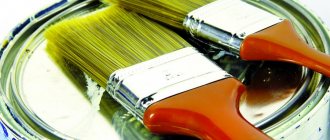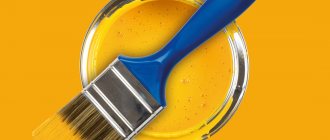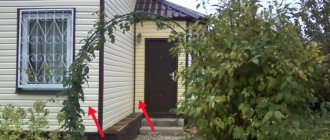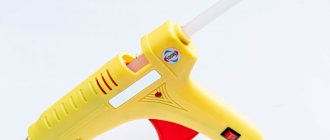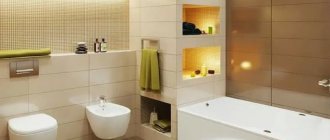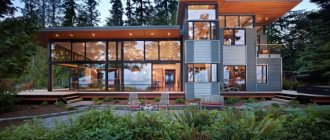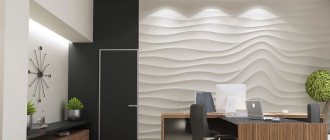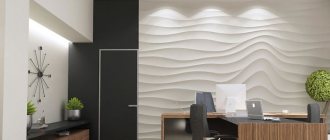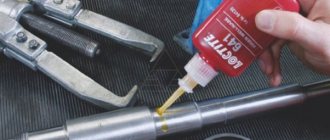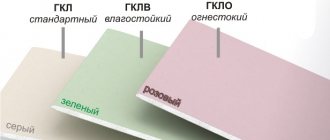- July 7, 2020
- Repair Tips
- Elena Kerra
The bathroom can be called the wettest room in the house. In addition, there is a significant temperature difference every day, which is caused by people using large volumes of hot water, for example, for bathing. Due to these operating conditions, special requirements are placed on the material for finishing walls and ceilings in the bathroom. It must be resistant to moisture, temperature changes, and mold formation.
PVC panels satisfy all these requirements. Finishing a bathtub with this material is also popular for the reason that it belongs to the category of budget products, and therefore is accessible to most of the population. PVC panels (also called plastic) can be found at prices starting from 140 rubles. for 1 m2. Considering that bathrooms are generally small in size, renovations are not too expensive.
But is it possible to use cheap PVC panels in residential premises? Are they dangerous to human health? Which PVC bathroom panels are best to use? Which manufacturers produce quality products, and which ones are better to avoid? In our article you will find answers to these questions.
General information about PVC panels
This material is made from polyvinyl chloride (PVC), which is a colorless transparent plastic. A variety of color variations of finished products is achieved by adding dyes and pigments to the composition. The result is colored PVC panels. They come in all possible shades.
It is the richness of color schemes that allows you to beautifully and originally decorate your bathtub with PVC panels. The photos posted in the article clearly demonstrate this.
The cost of this material varies widely. Basically, sellers set the price for 1 piece, however, the panels can have completely different sizes.
The cost of a unit of goods ranges from 40 to 350 rubles. To some extent it depends on the popularity of the brand. In addition, the price is influenced by the following indicators:
- panel thickness (the larger it is, the more expensive);
- method of drawing;
- materials from which the products are made;
- additives included in the composition.
Advantages and disadvantages
To answer the question of which PVC panels for the bathroom are better and which are worse, you need to understand what their pros and cons are. This material has the following advantages:
- Moisture resistance. Plastic panels are not at all afraid of water. They do not get wet, do not swell, and do not deform under the influence of moisture.
- Easy to care for. The panels can be washed daily. In this case, it is allowed to use any detergents suitable for plastic.
- Ability to withstand high temperatures. Some manufacturers claim that their panels can be used even if the thermometer rises to +80 °C. This is only true for materials that contain special heat-resistant additives. Other PVC panels can withstand temperatures up to +60 °C. But this is quite a lot.
- Aesthetic appearance.
- Variety of types, colors, textures.
- Relatively easy to install.
- Possibility of dismantling. This is true if the panels were attached to the frame.
- Relatively low cost.
It should be noted that PVC panels have serious disadvantages. This:
- Fragility. Even panels that are glued to the wall (rather than attached to a frame) are easily damaged if accidentally hit with a blunt or sharp object.
- Flammability. This material does not support combustion (does not ignite), but under the influence of fire it melts, releasing toxic fumes.
- Toxicity (under certain conditions). Above we noted what temperatures plastic can withstand. These parameters mean that until critical levels are reached, the panels will retain their shape and appearance. However, even with slight heating, this material is capable of releasing dangerous volatile compounds into the environment. This is especially true for cheap panels. Often there is an unpleasant odor in the room where they are used. It can even occur when the panels are heated by sunlight. Everyone knows that toxic substances are very dangerous to health. Many of them are carcinogens. Therefore, the answer to the question of which PVC panels for the bathroom is best to purchase is obvious. You need to make a choice in favor of certified products. Such panels are made from high-quality and safe materials.
- Loss of presentation under the influence of ultraviolet rays. Cheap panels fade (burn out) in the sun. In addition, temperature changes can also cause some deformation.
- Low frost resistance. Polyvinyl chloride can withstand frosts down to -15 °C. Therefore, in many regions of Russia, plastic panels are not used for outdoor work. In areas with harsh winters, it is not recommended to decorate even loggias and balconies with them.
"Century"
A brand from Russia, using Western technologies and raw materials. It also relies on the environmental friendliness of the material, so it is slightly inferior in strength. However, according to other criteria, it takes a worthy place in our ranking of PVC manufacturers:
- low prices;
- a large number of diverse collections;
- own design bureau;
- ease of installation;
- coating that ensures durability of the pattern.
Manufacturers
Currently, hundreds of large and small companies produce building materials. Which manufacturers of PVC panels for the bathroom are best to focus on when purchasing this type of product? Experts advise choosing products from well-known brands. Leading companies value their reputation, so they offer certified panels for sale. They are safe for health. Among domestic manufacturers, the following have proven themselves well:
- "Plast-Decor";
- AnV-Plast LLC;
- "Ural-Plast";
- LLC "Planet Plastic";
- "Decoplast";
- "Sadko"
- "Kronaplast";
- "Komplast";
- "Alta-Profile";
- Green Line LLC;
- Pareti LLC.
They offer quality material at a relatively low price. Among the leading foreign firms, the following should be highlighted:
- Forte (Italy). The company's product range is quite wide. Among the products produced are Le Murino plastic panels covered with stone chips.
- Deceuninck (France).
- Venta (Belgium). It also has production workshops in Russia. This allows us to produce products of European quality at affordable prices.
- Chinese products, as a rule, are not of high quality. However, this does not apply to Shanghai Zhuan. It produces certified panels at reasonable prices.
- Grossfilex (France). It also has its own factories in Russia for the production of plastic panels.
- Blancoplast (Germany).
- Vox (Poland).
- Wavin (Netherlands).
- Rolplast (Belgium).
How to calculate the required quantity
Calculation of the amount needed to sheathe can be made after determining the perimeter. The area of windows and doors should be subtracted from the total number.
Calculation example:
- a*b - base perimeter;
- с – wall height;
- d – area of all windows;
- e is the area of all doors.
- g – area of one panel.
Let's calculate the total area of the walls:
a*b*s.
From the obtained value you will need to subtract the area that does not need to be lined with plastic options:
a*b*c – d – e = f.
To obtain the final quantity number, you will need to perform the last operation:
f/g.
The result obtained is always rounded up.
Additionally, it should be noted that during installation work, waste will certainly arise.
That is why experts recommend buying 10% more material.
An example of calculating the required number of panels
PVC wall and ceiling panels
In stores and on the market, this product is presented in a wide range. Despite this, all plastic panels are divided into 2 types:
- Wall.
- Ceiling.
Their main difference is thickness. Both wall and ceiling panels are modules of two thin plates connected by stiffeners. Outwardly, they resemble honeycombs. The more stiffening ribs, the stronger the product.
Ceiling panels, as a rule, are extremely rarely subjected to various mechanical stress, but they should be as light as possible. This is especially important if they are attached to the ceiling with glue, and not mounted to the frame.
Wall panels, since they are constantly within human reach, are more often subject to unwanted mechanical influences. To make them last longer, they are made more durable. For the reasons noted above, ceiling panels are produced with a thickness of 5-8 mm, and wall panels - 8-12 mm.
Another difference (albeit not typical) is the color scheme. Ceiling panels are mainly produced in light colors. Although there are other options. Walls can be not only of all colors and shades, but also with a pattern, and also have a texture that imitates stone chips, brickwork, and so on. Undoubtedly, a bathtub decorated with such PVC panels looks amazing. Photos of design options confirm this.
Conclusion
Finishing a bathtub with plastic panels with your own hands is much easier than you think; mastering the job is not difficult for anyone, and the savings will be simply enormous, because specialists charge 450-500 rubles for installing a square meter of PVC panels. The video in this article will help you understand the workflow even better, and if you still don’t understand something, then write all your questions in the comments below.
Did you like the article? Subscribe to our Yandex.Zen channel
October 24, 2016
Bathroom, Bathroom and toilet design, Finishing materials
If you want to express gratitude, add a clarification or objection, or ask the author something, add a comment or say thank you!
Other classifications of PVC panels
You need to know them in order to choose exactly the material that is best suited for your bath. All wall and ceiling panels are divided into several types. The dimensions of the modules, the type of surface and edge, and the method of applying the pattern are taken into account.
According to the type of panel surface there are:
- Matte.
- Glossy.
- Semi-gloss.
Shine or dullness is achieved by applying a certain type of varnish to the surface. The technical characteristics of such plastic panels are the same. The choice depends only on the preferences of the buyer.
Based on the type of edge, panels are divided into:
- Seamless.
- Suture.
This classification is very arbitrary, because absolutely seamless plastic panels do not exist. For some materials, the edge is made in such a way that it is practically invisible. That's why they are called seamless. As a rule, these are the materials that are used to create wall paintings and compositions. But if you are renovating a bathroom with PVC panels of the same color, you can notice the seam.
There are design projects in which it is not hidden, but used as a decorative element. Seam panels are suitable for such cases. They have raised joints that create an interesting effect on the surface. Many people prefer to use these particular PVC panels for the bathroom. In the photo below you can see how they look on the wall.
Based on size, PVC panels are divided into the following types:
- lining;
- sheet;
- panel.
Let's look at this classification in more detail.
How to make a choice
Choosing the best material to decorate a room and disguise pipes and other flaws in the house is difficult. It is important to consider the following points:
- integrity of the packaging - in case of damage, it is better to refuse the product, because the sheets may be damaged;
- absence of arcuate protrusions;
- belonging to one party. Products from different batches may differ in shades, which will complicate the design of the bathroom;
- color - light glossy sheets will help to visually increase the area of a small room;
- quantity - it is necessary to provide for the possibility of replacing sheets damaged during installation;
- the size of the canvases should optimally correspond to the size of the room so that less waste remains after installation;
- the density of the joining of panels - the absence of noticeable gaps if the panels are seamless.
To make the best choice, you must first decide on the type of facing material: tiles, glass, MDF, laminated sheets, mosaic, false or aquapanel. It is important to determine the purpose and area of installation, and in addition to select the optimal size of the canvas. You need to pay attention to color design to create a unified design throughout the entire house. For longer operation of the product, it is worth contacting a specialist, because proper installation extends the service life of the finish.
Lining
These panels look like thin boards. Their width can be in two options:
- 10 cm;
- 12.5 cm.
The length of the modules is 3 meters. Lining also has its own classification. So, panels 10 cm wide are:
- ordinary;
- with a wide lock;
- with a narrow lock.
The color of the lining is usually monochromatic (usually white). Colored is rare. Lining with a pattern is practically not produced. These panels can be seamed or seamless. The latter are mainly used for finishing ceilings.
Features of care
It is not allowed to use preparations with abrasive components, as well as brushes or hard brushes when cleaning the panels. They damage the surface of products and cause dirt deposits to accumulate in the cracks formed. You should also not use such products because they spoil the appearance of the panels.
Most bathrooms are attacked by black mold. To remove fungus from the panels, you can use special antifungal drugs. Soap stains are easily removed with water to which lemon juice is added (the proportions should be 1:10). A rubber spatula will help remove dirt that accumulates between the panels.
Panel
These materials differ significantly from lining. The panel width varies from 15 to 50 cm. The most popular is 25 cm. The length of the modules can be as follows:
- 2.6 m;
- 2.7 m;
- 3m.
Another important difference is the type of edge. The panels are produced mostly seamless. In addition, they are often decorated with designs. A bathtub made from PVC panels of this category looks very beautiful. You can choose a pattern in the form of stonework or marble slabs. Many people like marine themes or flowers. There are incredibly many options.
Sheet
These panels are significantly different from those described above. Most often they are made from foamed PVC. The thickness of the sheets varies from 1 to 30 mm.
The width and length of this type of panel varies significantly. These parameters can range from 327 to 2000 mm. When producing sheet panels, special substances are added to the composition, making the material impact-resistant and very light. Due to this, it has wide application.
Which PVC panels for the bathroom are better? What to take, clapboard or sheet? Perhaps it would be better to purchase a panel? The answers to these questions depend on the purpose of using the material. For finishing ceilings, lining is often used, since it is lighter. Sheets are definitely not suitable for this purpose, as they are more difficult to install.
What to consider when installing the frame
Since the bathroom is a place with a high concentration of humidity, it is best to choose more resistant materials for the frame - metal or plastic.
Such profiles do not require additional processing to protect against pests, mold and water. The direction of the slats depends on the laying of the plastic panels. If you plan to lay the slabs vertically, the frame should be directed parallel to the floor. When installed horizontally, the slats are strictly vertical. In rare cases, diagonal laying is used, but this is technically more difficult to implement. In addition, diagonal cladding will require much more material, leaving a lot of scraps.
If the walls in the bathroom are uneven, covering them is somewhat more difficult. Irregularities are pre-closed using spacers made of wood or plastic. Also, on uneven walls you need to use a level more often to monitor the accuracy of the lines and masonry.
Methods of drawing
There are several of them:
- Offset printing. This is the most budget option. The pattern is rolled onto the surface using a special roller. The top of the product is coated with glossy or matte varnish. Using the offset printing method, they create an imitation of tree bark, stone, marble, and so on.
- Thermal transfer. In this case, a film with a pattern is pressed onto the surface of the panels and ironed with a silicone roller heated to 180 degrees Celsius. Under the influence of heat, the image is printed on the panel, after which the film is removed. Such surfaces do not need to be coated with varnish, since the color pigments of the design are securely attached to the product. They do not wash off or wash off.
- Lamination. With this method, the panels are covered with a very durable film. It gives the product a decorative appearance and protects it from mechanical deformation. Laminated panels are more expensive than others. However, they are also more reliable.
Which PVC panels for the bathroom are better? Undoubtedly, laminated ones are most suitable for wall decoration. Their main advantage is increased strength. However, there are other criteria that need to be taken into account when purchasing this material.
Price
The average cost of finishing panels can vary depending on the size, appearance and source material.
The following collections are especially popular:
- tree;
- textures;
- divorces;
- wallpaper.
The price of a high-quality slatted panel starts from 120-150 rubles, and a laminated panel starts from 180 rubles. The category of the most expensive options includes cladding with panels with a 3D effect.
In recent years, finishing has increasingly been carried out using affordable PVC panels, which are the best option in terms of price and quality.
Finishing work
Nowadays, many people try to decorate their bathtubs with PVC panels. It is not very difficult to do this with your own hands. It is important to take into account that you will have to buy not only the panels themselves, but also other components:
- Corners internal and external.
- Start (finish) bar. It is needed to make a beautiful frame for the cladding.
- Skirting boards (needed if the panels are laid on the ceiling).
- H-shaped profile. Needed for extending panels.
- F-shaped profile. Used for finishing cladding in corners.
PVC panels can simply be glued to the walls. At the same time, their surface should be as smooth and even as possible. If you don’t want to level the walls, you can mount the panels on the frame. It is made from wooden, plastic or metal slats. They are attached to the walls with dowels.
The frame method is most often used for laying PVC panels in the bathroom. Even a person who has never done this can do the work with his own hands. Basic rules to follow:
- The slats are installed at a distance of 50-60 cm from one another. They should be positioned perpendicular to the panels. That is, if you place them vertically, the slats need to be installed horizontally.
- They should fit snugly against the wall. If the surface is so uneven that there are gaps of 5 mm or more, special spacers should be inserted between the wall and the batten.
- The evenness of the finish must be checked with a plumb line.
- The panels are attached to the rails with special clamps or self-tapping screws. They are fastened together using grooves on the edges.
- Panels can be drilled and cut.
Advantages of plastic finishing
- for installing panels on the walls and ceiling of the bathroom, no preliminary preparation by plastering with wet solutions is required. All irregularities are eliminated during the manufacture of the frame, which is mounted using a level and plumb line;
- if water pipes are installed in the bathroom without being embedded in the walls, then they can be hidden in the installation space of the frame, and no rework is required, as with tiled walls. The same rule applies to electrical wiring, which is simply put into special hoses;
- it is allowed to install thermal and sound insulation simultaneously with the installation of the frame;
- finishing with plastic panels in the bathroom looks monolithic, but is considered a ventilated material, since there are tiny gaps. Moisture will never form in the space between the wall and the plastic; it will dry out naturally;
- They are classified as environmentally friendly internal coatings that do not emit harmful substances into the environment. Plastic is not a good environment for germs and microorganisms to live;
- is a very durable material, wear-resistant and unaffected by light rays;
- Regular cleaning of the surface is carried out with any available detergents.

